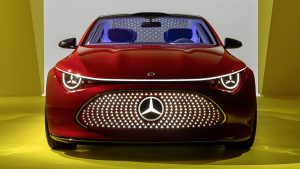Modern successor of iconic roadster 300SL gets a complete makeover with modern features, larger market share, and strong connections to its roots

Much is said in the business world about developing a strong image for a product. Books, websites, social-media posts tirelessly repeat that it is important to engage its target audience, to build an emotional connection that will retain customers over time… It is easy to see that it all makes sense, of course. But do you know why is that? More importantly, do you know is that applied in practice?
The automotive industry has many examples of that. Cars are expensive products, so people do not change them often. They make part of our routine and our leisure time whether we own one or not and that naturally helps them build strong connections with us. Being one of the oldest automakers still active, Mercedes-Benz has become a quite interesting example of how that connection is built.

How did the SL-Class history start?
1952 was an unforgettable year for Mercedes-Benz: by November, the 300SL had won in Berne, Le Mans and Nürburgring, but the biggest challenge was yet to come. The Carrera Panamericana was one of the most difficult endurance races held at the time and would take place in Mexico over four days and 3,100 km. The German automaker was surely going to give it a try using its flagship model.
Two teams entered the race with cars previously tested in Austria to simulate the high altitudes of the Mexican track. During the first stage, a vulture smashed through the windshield at a high speed, hitting the co-driver on the head. After being reanimated by the driver, he asked to continue with the race and so they did. They ended in third place, just behind the other Mercedes-Benz team.

How did it go to the streets?
The 300SL’s impressive history of victories called the attention of Max Hoffman, Mercedes-Benz’s importer in the USA back then. He suggested designing a toned-down version focused on urban use for wealthy enthusiasts. In 1954, the company responded with not one, but two models: the W198, which became famous for its Gullwing doors, and the W121 BII, a smaller and simplified version.
By 1963, the SL’s W113 generation repeated the predecessor’s front grille and vertical “fishbowl” headlights and was distinguished by a slightly concave hardtop, which gave it the “Pagoda” nickname because of the similarity with the typical Asian tower design. Nevertheless, it still earned a list of motorsport victories: one of them is the 1964 Spa-Sofia-Liège rally, which took place over 6,600 km.

Transformation into an urban legend
Successor R107 debuted in 1971 and became one of the cars Mercedes-Benz produced for the most time, available for eighteen years. After that, the R129, R230 and R231 generations wrote a market-oriented history, being the company’s best expression of how to balance elegance and sportiness: it has survived competition even from other Mercedes roadsters, such as the SLK/SLC and the GT.
Such balance comes from that effort to preserve the car’s image. The external design always uses a low and wide stance to replicate the original 300SL’s. The hood is long and boxy to put the engine in evidence. The headlights are usually small to make room for the grille. The rear end is sloped as to emulate fastback design, and so on. The latest generation, R232, adds some components of its own.

2022 with a touch of 1952
The all-new project uses many modern technologies to represent the SL’s concept better than ever. The spaceframe uses aluminum to weigh only 270 kg, the removable roof is now made of fabric to lower the center of gravity, the instrument cluster uses a high-tech visor to avoid sunlight with the top down and, with the same intention, the freestanding central display has adjustable inclination.
Besides all that, this model was entirely developed by Mercedes-AMG, the company’s performance branch. A notable consequence is that every version uses the Panamericana radiator grille, which is already present in the AMG versions of several other models. As you have probably guessed, it is named after the vertical-slat design initially used at the racing champion 300SL designed in 1952.

That’s how a strong image is built
The SL-Class is a great example because Mercedes-AMG has worked on every front. The new model not only borrows features from several predecessors but also applies them with the same intention of their original uses. That helps create a sense of consistency, where all the design components convey a coordinated message, and makes the whole car look aesthetically pleasant and satisfying.
This generation brings an all-new project with some features used for the first time, such as the 2+2 cabin, but all of them were designed in a way as to look familiar and aligned with what the SL Class represents since its racing origins. The automaker is so confident that it designed the R232 roadster with enough capabilities to replace the GT Roadster and, to some extent, the S-Class Convertible.

Among all the design elements applied to the SL Class’s latest generation, the Panamericana grille is surely the most expressive one: it honors the iconic 300SL predecessor and its long history of racing victories and helps the current car prosper in its mission of becoming Mercedes’s flagship roadster once again. What do you think of it? Share your thoughts and opinions using the button below!
Danillo Almeida has explored his passion for cars in two distinct ways. The first one is his graduation course in Mechanical Engineering, which will hopefully lead to a job position in the field. The other one is expressing his knowledge and opinions on the matter through writing. Almeida has already contributed to blogs, stores, and websites in general writing automotive content in many formats.

